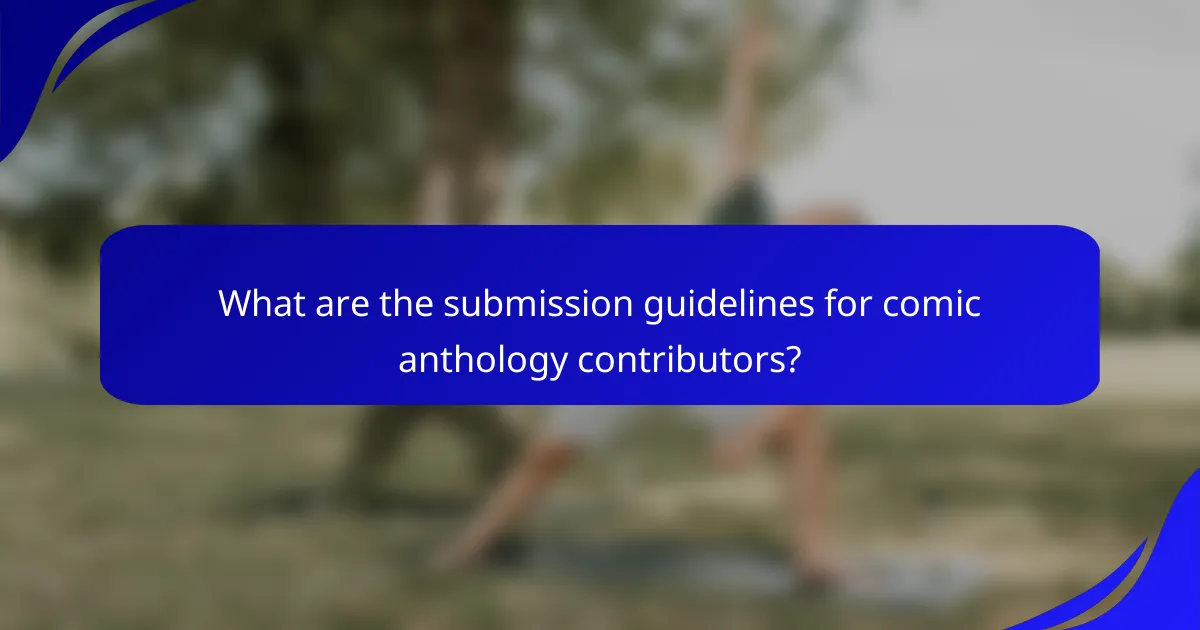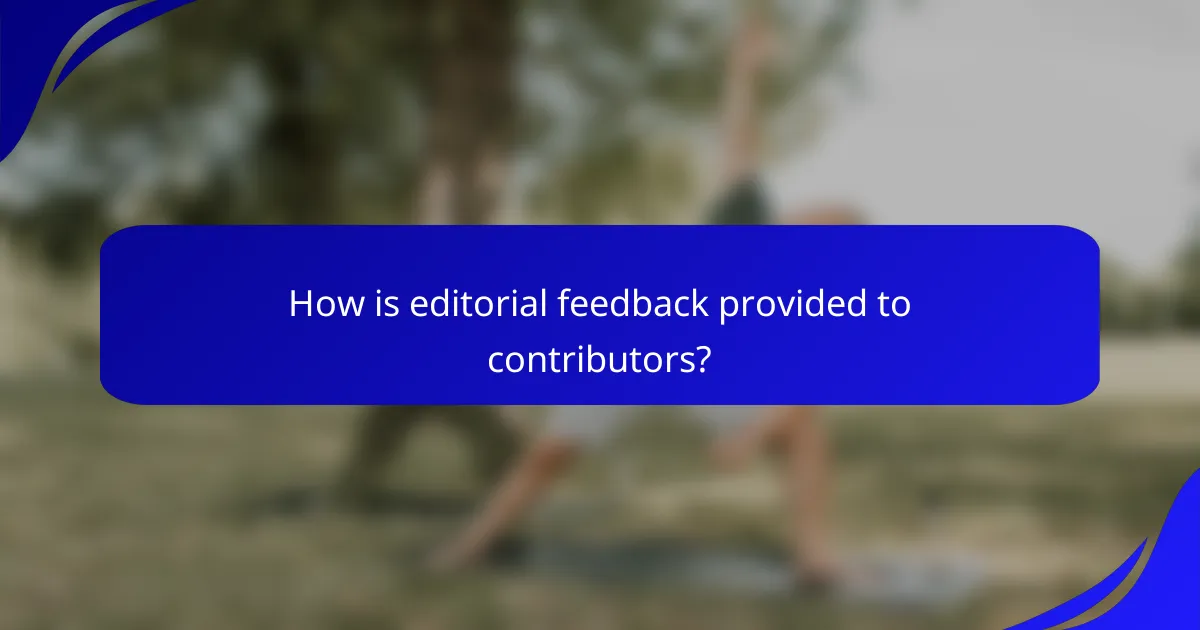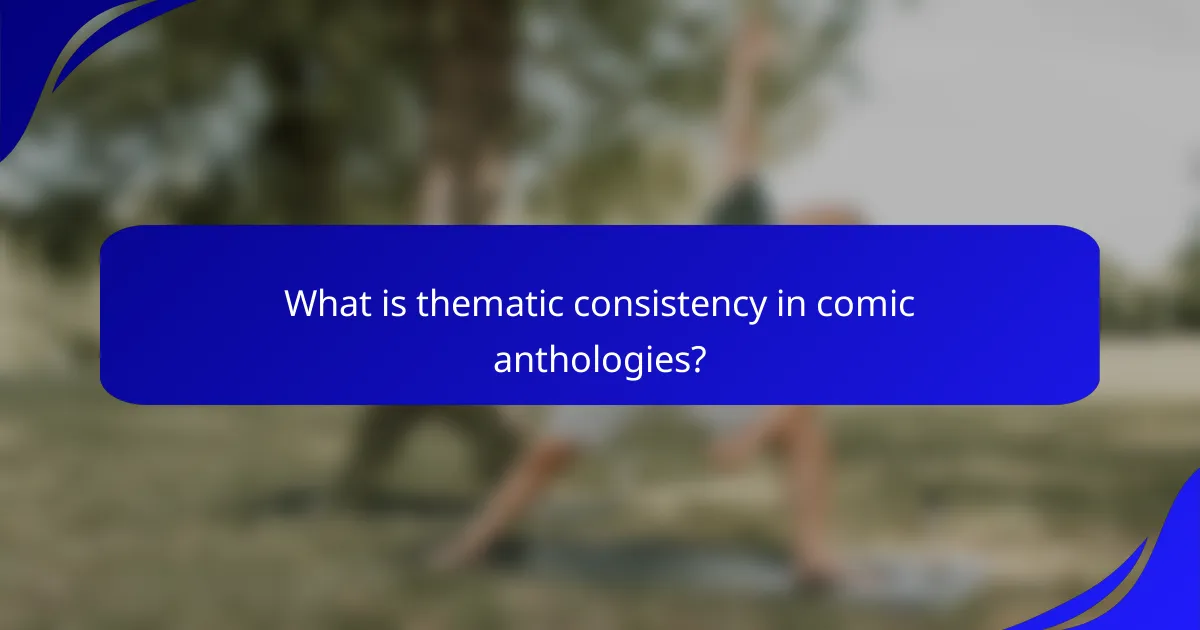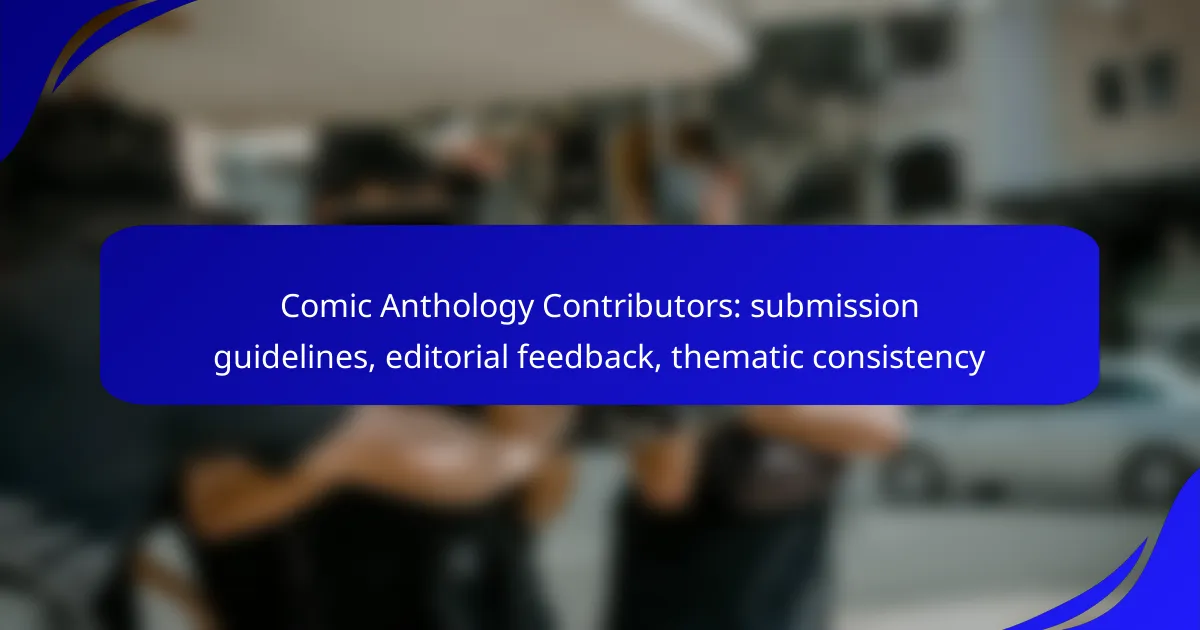Contributors to the comic anthology must follow specific submission guidelines, which include details on formatting, length, and deadlines to ensure their work is properly evaluated. Editorial feedback will be provided to help enhance submissions and maintain thematic consistency, ensuring that all contributions resonate with a unified message and purpose.

What are the submission guidelines for comic anthology contributors?
Comic anthology contributors must adhere to specific submission guidelines to ensure their work is considered. These guidelines typically cover formatting, length, submission platforms, deadlines, and contact information.
Formatting requirements
Submissions should be formatted according to the anthology’s specifications, which often include guidelines on page size, resolution, and file type. Common requirements are to submit artwork in high-resolution PDF or TIFF formats, with dimensions typically set at A4 or letter size.
Additionally, ensure that text is legible and appropriately sized, usually around 10-12 points for body text. Pay attention to margins and bleed areas, as these can affect the final printed product.
Length specifications
Length specifications for comic anthology contributions can vary widely, but most anthologies prefer stories that range from a few pages to around 10 pages. Shorter pieces may be more suitable for themed anthologies, while longer narratives can be accepted in larger collections.
It’s essential to check the specific anthology’s guidelines, as some may impose strict word counts or page limits. Aim for concise storytelling that fits within the given constraints.
Submission platforms
Many comic anthologies accept submissions through online platforms, such as Submittable or their dedicated website. These platforms streamline the submission process and allow contributors to track their submissions easily.
Some anthologies may also accept submissions via email, so it’s crucial to follow the specific instructions provided in the guidelines. Always ensure that your files are named appropriately and include all required information in your submission.
Deadline details
Submission deadlines for comic anthologies can vary, with some open year-round while others have specific windows for submissions. It’s important to note these deadlines clearly, as late submissions are often not considered.
Check the anthology’s website or submission platform for exact dates, and consider setting reminders to ensure you submit your work on time. Being aware of any thematic deadlines is also crucial if the anthology is centered around a specific topic.
Contact information
For inquiries regarding submissions, most anthologies provide contact information on their website. This may include an email address or a contact form for questions about guidelines or submission status.
When reaching out, be concise and respectful, as editors often receive numerous inquiries. Always refer to the guidelines before contacting to ensure your questions are not already answered there.

How is editorial feedback provided to contributors?
Editorial feedback for contributors is typically provided through structured communication, often via email or a dedicated platform. This feedback aims to enhance the quality of submissions and ensure thematic consistency across the anthology.
Feedback process overview
The feedback process begins after submissions are reviewed by the editorial team. Contributors receive detailed comments on their work, highlighting strengths and areas for improvement. This dialogue fosters a collaborative environment where contributors can refine their pieces.
Contributors may be invited to discuss feedback in follow-up meetings or through written exchanges. This interaction can clarify editorial expectations and help align the work with the anthology’s vision.
Types of feedback
Feedback can be categorized into several types, including content suggestions, structural advice, and stylistic recommendations. Content suggestions focus on thematic elements and narrative coherence, while structural advice addresses pacing and organization.
Stylistic recommendations often involve tone, voice, and language usage. Contributors should be open to all types of feedback, as each plays a crucial role in enhancing the overall quality of their submissions.
Response timeframes
Editorial feedback is generally provided within a few weeks after the submission deadline. Contributors can expect initial comments to arrive promptly, allowing time for revisions before final selections are made.
In cases where extensive revisions are needed, additional time may be allocated for further feedback. It’s advisable for contributors to plan their schedules accordingly, ensuring they can respond to feedback in a timely manner.

What is thematic consistency in comic anthologies?
Thematic consistency in comic anthologies refers to the coherent and unified theme that ties together the various contributions within the collection. This ensures that the stories resonate with a shared purpose or message, enhancing the overall reading experience.
Importance of thematic coherence
Thematic coherence is crucial as it creates a sense of unity among diverse narratives, allowing readers to engage more deeply with the anthology. When contributors align their work with a central theme, it fosters a more immersive experience and encourages readers to explore the nuances of that theme across different perspectives.
A strong thematic focus can also enhance marketing efforts, making it easier to target specific audiences who are interested in that theme. This can lead to higher sales and greater visibility in a crowded market.
Examples of successful themes
Successful themes in comic anthologies often revolve around universal concepts such as identity, love, or social justice. For instance, an anthology centered on “overcoming adversity” could feature stories that explore personal struggles, societal challenges, and triumphs from various cultural backgrounds.
Another example is an anthology themed around “the future of technology,” which could include narratives that examine the impact of AI, virtual reality, and ethical dilemmas in a tech-driven world. These themes not only resonate with readers but also invite diverse interpretations and storytelling styles.
How to maintain thematic focus
To maintain thematic focus, it’s essential for contributors to clearly understand the anthology’s theme before submitting their work. A well-defined theme should be communicated in the submission guidelines, allowing creators to align their stories accordingly.
Regular editorial feedback can help ensure that submissions remain on track. Editors should provide constructive criticism that emphasizes the theme, guiding contributors to refine their narratives without losing their unique voice. Additionally, organizing contributions into sections based on sub-themes can enhance coherence while allowing for variety.

What are common pitfalls in submissions?
Common pitfalls in submissions include failing to adhere to guidelines, lacking originality, and presenting work poorly. Avoiding these mistakes can significantly enhance the chances of acceptance in a comic anthology.
Ignoring guidelines
Ignoring submission guidelines is one of the most frequent errors made by contributors. Each anthology has specific requirements regarding formatting, length, and thematic elements that must be followed closely.
To avoid this pitfall, carefully read the submission guidelines before sending your work. Create a checklist to ensure you meet all the necessary criteria, such as file type, page count, and any required cover letters.
Lack of originality
A lack of originality can lead to rejection, as anthologies seek fresh perspectives and unique storytelling. Submissions that closely mimic existing works or rely on clichés often fail to stand out.
To foster originality, brainstorm unique concepts and develop characters with depth. Consider how your story can offer a new twist on common themes or explore underrepresented voices within the genre.
Poor presentation
Poor presentation can undermine even the most compelling stories. Submissions that are cluttered, poorly formatted, or riddled with typos can distract from the content and leave a negative impression.
Ensure your work is polished before submission. Use clear fonts, maintain consistent formatting, and proofread for grammatical errors. If possible, seek feedback from peers or use professional editing services to enhance the overall quality of your presentation.

What are the key criteria for selection?
The key criteria for selection in a comic anthology include artistic quality and storytelling effectiveness. These aspects ensure that submissions resonate with readers and maintain a cohesive theme throughout the collection.
Artistic quality
Artistic quality refers to the visual appeal and technical skill demonstrated in the artwork. Submissions should exhibit a strong command of drawing techniques, color usage, and overall composition. High-quality art can significantly enhance the reader’s experience and engagement with the story.
When evaluating artistic quality, consider factors such as style consistency, clarity of visuals, and originality. A diverse range of artistic styles can be welcomed, but each piece should align with the anthology’s overall aesthetic. Avoid overly cluttered or unclear images that detract from the narrative.
Storytelling effectiveness
Storytelling effectiveness measures how well a comic conveys its narrative and engages readers. A strong submission should have a clear plot, well-developed characters, and a compelling emotional arc. The pacing and structure of the story are also crucial, as they influence how readers connect with the material.
To enhance storytelling effectiveness, focus on creating relatable characters and dynamic dialogue. Ensure that the narrative flows smoothly and maintains reader interest from start to finish. Avoid clichés and strive for fresh, innovative plots that resonate with the anthology’s theme.
